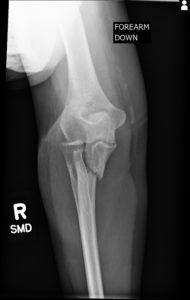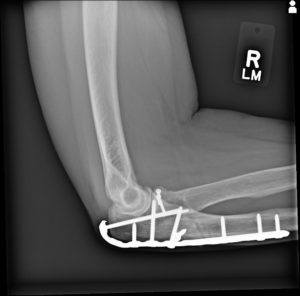Elbow Fractures
What is an Elbow Fracture?
An elbow fracture or broken elbow occurs when one or more bones that form the elbow joint is broken. The elbow is a joint made up of 3 bones: the distal humerus, the olecranon and the radial head. Any or all of these bones can be broken.
What Causes an Elbow Fracture?
Elbow fractures can result from high energy injuries such as car accidents or motorcycle crashes or from falls on an outstretched hand. The bones can be broken into many pieces or just crack slightly depending on the quality of bone and the type of injury.
What Does the Elbow Do?
The elbow is an important joint because it allows humans to get the hand to the mouth. The ulnohumeral joint is a hinge joint between the distal humerus and the olecranon that provides flexion and extension. Any deformity can cause loss of motion in either plane. The radiocapitallar joint is a pivot joint that assists in pronation and supination. It is also an important stabilizer of the elbow to valgus stress.
How is an Elbow Fracture Diagnosed?
Physical examination is important in the evaluation of these injuries. Important nerves and blood vessels run next to this bone and can be injured when it breaks. The doctor will ask you to move your fingers and wrist during the exam. It may feel like torture, but it is an important part of the exam process. The doctor will look for any open wounds over the injury as these usually require surgery.
X-rays are used to evaluate the location and severity of the broken bone. This helps doctors and patients make an informed decision on treatment. Often two or more x-rays are taken to show the injury pattern. If the elbow is broken into many smaller pieces, a CT (Computed Tomography) scan is often ordered to help with accurate diagnosis and surgical planning.
Elbow Fracture Treatment
Simple fractures where the bones are non-displaced usually don’t require surgery. In cases where the bones have moved out of place, elbow fracture surgery may be required.
Non-Surgical Treatment for Elbow Fractures
Most elbow fractures in adults require surgery. However, several types of elbow fractures can be treated without surgery. If the fracture is nondisplaced, these can often be treated in a splint or hinged elbow brace. Nondisplaced, small radial head fractures are often treated in this manner. In patients with multiple medical problems or in whom surgery is unsafe, non-operative care is sometimes indicated even in displaced fractures.
If non-operative care is chosen, regular follow-up care for a physical exam and xrays is important to ensure that the fracture stays in good position and heals appropriately. Cutting down or quitting smoking and tight blood sugar control if you are a diabetic is important for the healing process. One fall or continued lack of compliance with bracing can pull the bone ends apart and result in the need for surgery.
Depending on health and injury pattern this elbow can take 3-4 months to heal without surgery. The elbow is prone to stiffness when immobilized. Intense physical therapy for shoulder and elbow range of motion is often required once bone has healed enough to prevent displacement with motion
Surgical Treatment for Elbow Fractures
Elbow fracture surgery may be required to fix the broken elbow if the pieces are displaced. Each bone and fracture type can be treated with several different treatment options. These surgeries can be combined when multiple bones are broken at the same time.
In children, distal humerus fractures are often treated with small pins placed through tiny incisions. In adults, the distal humerus is usually fixed with metal plates and screws placed an incision on the back of the elbow. Olecranon fractures are also commonly treated with plates and screws but some physicians still use wires to fix these injuries. Radial head fractures can be treated with small plates and screws in younger patients but in older patients or those with many small pieces a radial head replacement surgery is performed. In older patents with multiple fractures and poor bone quality elbow replacements can also be done but these are reserved for very low demand patients. Surgery usually takes 1 to 2 hours and can be done on an outpatient basis and patients can go home the same day. Ideally, surgeons like to perform this surgery within 1-2 weeks of injury. Thus, patients have time to seek a second opinion regarding treatment if more information or additional surgeon input is desired.
It is important to choose your surgeon wisely. Extensive surgical experience can be helpful in achieving a good result and avoiding complications. Collectively, ROC orthopedic surgeons have performed more broken elbow operations than any practice in northern Nevada and take pride in outstanding surgical results.
After surgery, patients are often given a splint or a brace. Gentle motion is begun early to prevent stiffness. Gradually this motion is increased and physical therapy is begun around 3-6 weeks after surgery. Elbow fracture injuries tend to develop significant stiffness and long term therapy is needed to regain good motion and strength.

Complications After Elbow Fracture Surgery
Complications can occur following elbow fracture surgery. There is always a risk of infection with any surgery, no matter how small. A dose of antibiotics given prior to surgery helps to make this risk as small as possible. There is always a risk of injury to blood vessels or nerves. This is reduced by having an experienced surgeon involved in your care. Noncompliance with weight bearing restrictions, too much motion or falls can result in the metal ripping out of the bone or the fracture separating. It is always possible that the bone may not heal and additional surgery will be required. This is usually associated with patient noncompliance, diabetes, or use of nicotine like smoking and chewing tobacco. Elbow injuries can also develop a condition called heterotopic ossification. This is a rare complication where the body makes additional bone around the elbow that prevents motion. Sometimes this bone requires removal for adequate function and pain control.
How Long Does It Take to Recover from Elbow Fracture Surgery?
Most people with elbow fractures do very well and return to prior activities and function. The bone usually takes 3-4 months to heal completely. Aggressive return to activity too early can result in re-fracture, hardware breakage or nonunion. Even when the bones are lined up and heal perfectly some residual elbow stiffness is common. Sometimes metal around the elbow becomes prominent or painful. It can be removed a year after the initial surgery.
In need of an orthopedic specialist? Schedule an appointment with one of our specialty-trained Trauma and Fracture doctors to talk through your options. Reno Orthopedic Clinic offers comprehensive treatment for a full range of traumatic injuries at multiple convenient locations in Reno, Sparks and Carson City.
